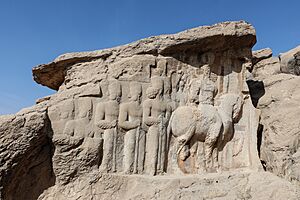Naqsh-e Rajab facts for kids
Naqsh-e Rajab (which means "Picture of Rajab" in Persian) is an important ancient site in Iran. It is located near the famous ruins of Persepolis in Fars Province. This special place is known for its amazing rock carvings. These carvings were made long ago by the Sasanian Empire, a powerful Persian empire that ruled from 224 to 651 AD.
The site of Naqsh-e Rajab is like an open-air museum. It shows us scenes of kings and important people from the Sasanian period. These carvings tell stories about their power and achievements.
Contents
What Are Rock Reliefs?
Rock reliefs are artworks carved directly into natural rock faces. They are different from statues, which are usually freestanding. In ancient Persia, carving reliefs into rocks was a popular way to show important events or powerful rulers. These carvings often celebrated victories, coronations, or the strength of the king.
The Sasanian kings used these reliefs to show their authority. They wanted to connect themselves to the land and its history. Naqsh-e Rajab is one of several places in Iran where you can find these impressive Sasanian rock carvings.
Who Created the Carvings?
The carvings at Naqsh-e Rajab were made during the early Sasanian period. Two very important kings are featured here: Ardashir I and Shapur I.
Ardashir I: The Founder
Ardashir I was the founder of the Sasanian Empire. He was a strong leader who united Persia. One of the carvings at Naqsh-e Rajab shows him. This carving might show his coronation, which is the ceremony where he officially became king. It highlights his importance in starting this new empire.
Shapur I: A Powerful King
Shapur I was Ardashir I's son and a very powerful Sasanian king. He ruled after his father and expanded the empire. Shapur I is famous for his military victories, especially against the Roman Empire. There are two main carvings at Naqsh-e Rajab that feature Shapur I.
Shapur's Coronation Scene
One carving shows Shapur I being crowned king. In this scene, he is shown with a god, perhaps Ahura Mazda, who is giving him the royal ring. This shows that the king's power came from the gods. It was a way to make his rule seem more legitimate and powerful.
Shapur's Parade Scene
The other carving of Shapur I is called "Shapur's Parade" or "Shapur's Triumph." This large carving shows Shapur I on horseback. He is surrounded by his family members and important officials. This scene likely celebrates his victories and shows off his royal court. It gives us a glimpse into the grand life of a Sasanian king.
Why is Naqsh-e Rajab Important?
Naqsh-e Rajab is very important for understanding the Sasanian Empire. The carvings here are some of the earliest Sasanian rock reliefs. They show us how the Sasanian kings wanted to be seen by their people and by history. They tell us about their beliefs, their power, and their achievements.
Studying these carvings helps historians learn about the art, culture, and politics of ancient Persia. It's a valuable historical record carved in stone.
Visiting Naqsh-e Rajab Today
Today, Naqsh-e Rajab is an archaeological site that many people visit. It's close to other famous ancient sites like Persepolis and Naqsh-e Rustam. These places together offer a wonderful look into the rich history of ancient Iran. When you visit, you can imagine the powerful kings who once stood before these very carvings.
See also
 In Spanish: Naqsh-e Rajab para niños
In Spanish: Naqsh-e Rajab para niños


